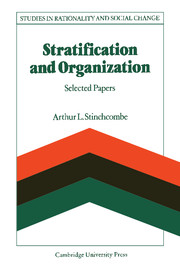Book contents
- Frontmatter
- Contents
- Acknowledgments
- 1 Rationality and social structure: an introduction
- PART I STRATIFICATION
- 2 Agricultural enterprise and rural class relations
- 3 Some empirical consequences of the Davis-Moore theory of stratification
- 4 Interdependence and inequality: a specification of the Davis-Moore theory (Co-authored with T. Robert Harris)
- 5 Marxist theories of power and empirical research
- 6 Social mobility in industrial labor markets
- 7 The sociology of ethnic loyalties
- 8 The deep structure of moral categories, eighteenthcentury French stratification and the Revolution
- PART II ORGANIZATIONS
- PART III SOCIOLOGY AS A PROFESSION
- Bibliography
- Name and place-name index
- Subject index
8 - The deep structure of moral categories, eighteenthcentury French stratification and the Revolution
from PART I - STRATIFICATION
Published online by Cambridge University Press: 06 July 2010
- Frontmatter
- Contents
- Acknowledgments
- 1 Rationality and social structure: an introduction
- PART I STRATIFICATION
- 2 Agricultural enterprise and rural class relations
- 3 Some empirical consequences of the Davis-Moore theory of stratification
- 4 Interdependence and inequality: a specification of the Davis-Moore theory (Co-authored with T. Robert Harris)
- 5 Marxist theories of power and empirical research
- 6 Social mobility in industrial labor markets
- 7 The sociology of ethnic loyalties
- 8 The deep structure of moral categories, eighteenthcentury French stratification and the Revolution
- PART II ORGANIZATIONS
- PART III SOCIOLOGY AS A PROFESSION
- Bibliography
- Name and place-name index
- Subject index
Summary
I shall apply structural analysis to the system of moral categories into which any society's population is classified, to the categories of the stratification of the old régime in eighteenth-century France, and discuss how the deep structures of the stratification culture of the old society shaped the nature of the Revolution which abolished that stratification structure.
The social functions of moral categories
In every society there are some categories into which people can be classified that pervade their whole lives: child–adult; male–female; citizen–alien; black–white; crazy–sane are examples of such categories in the United States. Further, there are other categories that pervade particular situations or social systems: in a house there is the owner or renter (and his or her family) and the guests. These categories dominate the situation of the particular house, in the sense that few of a guest's acts are not affected by his being a guest.
Furthermore, these categories have extension into the larger institutional order. If a guest oversteps his rights, the police and the courts will distinguish the tenant from the guest. If an insane person comes to criminal court he or she will be treated differently from a sane person. Blacks appear in the administrative records of fair employment enforcement with a different significance than do whites. Children are required to go to school – adults not.
- Type
- Chapter
- Information
- Stratification and OrganizationSelected Papers, pp. 145 - 174Publisher: Cambridge University PressPrint publication year: 1986
- 2
- Cited by



